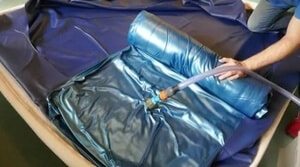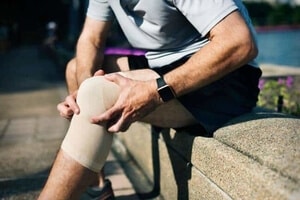We hope you love the product we recommend! Just so you know, at no extra cost to you, we may get a small commission for purchases made through links in this post. Your support is appreciated. Enjoy the read!
There are many different and (somewhat) contradicting opinions on whether or not waterbeds are good for you.
But I can see the points made from each side.
Maybe you like floating on water. Or you’ll wake up too often from the tidal waves of your partner’s tossing and turning. Sure, there are waveless mattresses, but baffle failures may be hard to fix.
Let me present the facts, add my honest opinions and then you be the judge.
Maybe after this article, you’ll become a big advocate too!

Are Waterbeds Good for Your Back?
That’s the million dollar question, isn’t it?!
From my research, there are several reasons why waterbeds are good for your back. On the same hand, there are 1 or 2 things to watch out for too.
Let’s read on to find out what these are.
Temperature Control
Who doesn’t like jumping into a warm and toasty bed on a cold winter night?!
I know I do!
Besides this obvious comfort,
“applying heat to an inflamed area will dilate the blood vessels, promote blood flow, and help sore and tightened muscles relax.”
According to Medical News Today, it’ll also help you up your fitness game by
“[improving] circulation [to] help eliminate the buildup of lactic acid waste [that] occurs after some types of exercise.”
Being about to have absolute control over how hot or cold the surface of something that comes into full contact with your body is amazing!

You can warm it up during the winter and cool it down in the summer. If you sleep hot and your partner sleeps cold, then it’s best to get a dual chamber.
Typically found in a Queen, King or California King, a waterbed can have two separate water bladders that are side-by-side.
This is a genius invention for two reasons:
- No motion transfer
This means that you can move all you want and the water waves on your side of the bed won’t affect your co-sleeper’s water bladder. Though I’m sure they can still hear you…
- Minimize the pressure points.
Without a lot of weight pressing into sensitive points on your body, the chances of you waking up to numbness or soreness are slim to none.
No Bedsores
Waterbeds were first invented to treat immobile patients who developed bedsores.
Doctors discovered that those who were resting on a waterbed didn’t develop ulcers built up by continuous pressure, and those who had it healed a lot faster.

Imagine sleeping in a position that might be comfortable but your own weight is crushing parts of your body.
That doesn’t sound very nice.
You may not get bedsores but will probably wake up with some tingling sensation or muscle soreness. I’m sure you’re not a stranger to this scenario and can agree that it’s not the most pleasant way to start off the day.
Why is a waterbed relevant in this case?
Well, let’s take a stroll down memory lane. Back to high school chemistry.
A waterbed is, well, made out of water. And water is a liquid. According to the Oxford Dictionary,
“A liquid is a substance that flows freely but is of constant volume, having a consistency like that of water or oil.”
A waterbed tailors to your body’s unique shape and curves because:
- the vinyl surface is thin and flexible enough to adapt to movements made on the surface, and
- the water inside displaces.
What is displacement?
For simplicity sake, when a rock is dropped into a bowl of water, the same amount water as the rock is “pushed out of the way.”
Now, because the liquid in the waterbed is contained, the displaced water has nowhere else to go except to fill the nooks and cranny of your body’s curve.
The result is not waking up with aches and pains the next day.
Because why would you?
Your body weight is supported and evenly distributed, your blood circulation isn’t unnecessarily blocked, and your spine is kept in neutral alignment.
Of course, this only works if you actually set up and maintain the bed properly. By properly, I mean don’t overfill or underfill the water level, add in water conditioner when you’re supposed to, and so on.
Lumbar Support
Sorry free flow models, but you aren’t a favorite of many chiropractors.
They’d prefer you to sleep on a semi-waveless or waveless model instead. These two options would have enough fiber layers inside to firmly support your entire body.
Many modern versions are designed for and come with more back support.
I suspect that extra lumbar layers are now the norm because, when waterbeds were first introduced, people complained about the lack of back support and potentially feeling seasick.
The layers are usually made of fiber or foam that are put inside the mattress. Besides acting as more padding for the spine, these layers also restrict water movement.
Most waterbeds have at least one layer inside unless you opt for a free flow mattress. Which feels like you’re floating on water and you can sense every ripple.
On top of these head-to-toe layers, models that offer lumbar support will have extra, shorter layers in the middle section of the bed for a more ergonomic feel.
Adjustable Firmness
This one’s pretty self-explanatory. Just like an air mattress, you can adjust the firmness of your waterbed to your liking.
You like it firmer?
Great, fill your mattress up more.
Too firm? No problem, drain a bit of the liquid out.
It’s even better if you have a dual water chamber, then both you and your partner can adjust to your individual preference without having to fight about it.
This leads to a better night’s sleep, which means you’ll wake up fully recharged and ready to take on the big day ahead of you.
When compared to other types of beds, the ability to customize the firmness level just for you is a unique benefit to have.

Here’s an interesting study done by the University of California and Veterans Administration Medical Center to help demonstrate the importance of mattress firmness level.
The researchers documented the results from patients with chronic lower back pain sleeping on 4 different types of mattresses:
- an orthopedic hard bed,
- a soft bed,
- a waterbed, and
- a hybrid.
Although the majority of patients saw an improvement in their condition with the hard bed, the next biggest group voted for the waterbed!
After 2 weeks of sleeping on the hard bed or waterbed, 25% of patients noticed their ability to raise their legs straight up has improved drastically.
No Motion Transfer
We mentioned this already, but it’s important so worth repeating.
With two water chambers instead of a singular giant one inside the mattress, you won’t have to worry about waking up your partner when you get up for your midnight pee.
Or vice versa.
They don’t have to feel bad about disturbing your slumber when they’re tossing and turning at night.

Along with two separate bladders, some models have movement-restricting layers of fiber or foam inserted inside to make the bed less sensitive and more sturdy.
This makes the motion isolation factor of waterbeds on par with other types of mattresses on the market.
What could that look like?
Well, imagine a well-rested couple who aren’t bickering all day about the littlest of things because they finally get to sleep like a baby at night!
Retains Shape
You won’t have to worry about your waterbed mattress sagging, dipping or denting.
You don’t even need to flip or rotate every so often to help keep its shape.
Why?
Because all solid material will deteriorate with repeated use over time. Eventually, the spring coils, memory foam or latex inside will break down.
But water won’t.
Liquids don’t get compressed. Instead, they get displaced.
This means the bed will last longer and won’t get bent out of shape even with daily use. That’s less headaches and more money in your pocket in the long run!
The Only Complaint
After endless research, I only found one reason why health practitioners were against the waterbed:
Not enough layers inside for back support
We covered this above already. The gist of it is…yes, it’s true, but this applies to only the earlier versions of the waterbed.
Especially the free flow models had almost ZERO back support.
But with innovation and technology, the versions we have today can be as firm and supportive as any other bed on the market.
Even farmers are switching from sand to waterbeds for their cows.
That’s strange, you might think.
It actually isn’t.
Cows need a floating bed too, ya know!
How come?
Well, dairy farmers want their cattle to be as comfortable as possible, so they can produce more milk.
A waterbed combats 3 major health issues that cows easily develop: swollen hocks (hind leg joint), hair loss on hocks and mastitis (milk leaks).
Switching to waterbeds mean that these farmers will end up with a healthier and more hygienic herd!
Are Waterbeds Good For Your Body?
Other than being good for your back, waterbeds are also good for the rest of your body.
Worried about some hardcore waves from your partner’s movements?
Don’t be!
The new version mostly has a dual chamber. This means that there are two separate water bladders beside each other, so the motion won’t transfer.
Now you can do all the backflips you want and not worry about affecting your partner’s sleep!
Besides that, you can also set your temperature pad to whatever degree you’d like without hearing your spouse complaining about it being too hot or too cold for them.
This is the best invention after sliced bread because this has been the bane of my existence. Finally, problem solved!
According to Medical News Today,
“Heat is also psychologically reassuring, which can enhance its analgesic properties.”
The heat from the temperature pad allows you to adjust to the exact degree that you like so your sore muscles can relax from a hard day’s work.
This is especially important for people with medical conditions like insomnia, back pain, arthritis, asthma, bed sores and more.
For all the women out there:
Think of a waterbed as a huge bag of warm water, because that’s basically what it is.
This is great news! Why?
Well, remember those painful cramps you get every month? Remember that hot water bottle that you fill with water and put against your tummy to calm those cramps?

Well, you can just sleep on this instead!
It’s also great for fitness enthusiasts who perpetually experience DOMS (Delayed Onset Muscle Soreness). I should know, I’m one of them.
Imagine the little ripples gently rocking you while the comfortable warmth lulls you into a cozy slumber.
Are Waterbeds Good for Your Health?
You know, our beds are the best breeding grounds for fungus, mold, dust mites, bed bugs, and other nasty things.
Yes, really! Think about it.
We lay there for a good one-third of our lives.
Our dead skin cells flake off there. Our sweat and other bodily fluids seep into the mattress. We recover from colds and the flu on there, spreading our bacteria everywhere on the surface. We eat and drink on our mattress. Our friends and family wear their dirty street clothes and sit on our clean, sacred bed.
Ew, I’m getting goosebumps just thinking about how gross that is.
It’s inevitable, but just how often do you wash your bedding and vacuum your mattress?
Yes, I said vacuum.
Oh, you didn’t know you can do that?
Well, you do now!
Sprinkle some baking soda on while you’re at it too.
Good thing waterbeds have the most hygienic surface of all mattresses.
Why is this?
Well, because they’re typically made of vinyl plastic wrapping.
Plastic doesn’t usually absorb, so as long as you keep it clean and wipe it down once in a while, you shouldn’t be collecting any microorganisms or allergens.
Problem solved!
Because of its allergen-free surface, waterbeds are known to be good for people who suffer from hay fever, asthma, and dermatitis.
There have also been studies where waterbeds proved to help children with autism fall and stay asleep, as well as help prematurely born infants grow.
Oh, the wonders of a waterbed!
Are Waterbeds Good for Arthritis?
What exactly is arthritis?
In its simplest terms, it’s joint inflammation.
However, it’s a broad term that is used to describe any of the 200+ conditions where the joints are inflamed. This includes gout, fibromyalgia, rheumatoid arthritis and 197+ more.
I actually know quite a few people with arthritis. Don’t think that it only happens to Baby Boomers! It’s showing up more and more in younger generations.

There was this Canadian study that monitored people for 18 years. What was the results?
They found that arthritis is developing in people younger and younger.
Why?
Besides genetics playing a small role, a lot of it comes from lifestyle choices – lots of reasons why: smoking, being overweight, muscle weakness, overuse and injury of cartilage…etc.
According to Medical News Today, one form of physical therapy that people can do at home by themselves is to use water.
“The water supports weight and puts less pressure on the muscles and joints”
Specifically, warm water.
Either soak in the hot tub, sit in a sauna or – my favorite – steam it out!
SAVVY TIP:
If you have access to a steam room, try putting a few drops of your favorite essential oil (mine is eucalyptus or rose!) on the mental tab where the steam comes out from – it’ll smell GLORIOUS!
If you’re not lucky enough to have friend or neighbor with a jacuzzi in their backyard that you can use nightly (I mean, we all got one of those friends, right?), then the next best thing would be – you guessed it – a waterbed!
Heat that bad boy up and enjoy as the warmth instantly soothes your tired muscles, tendons and joints. It’ll give you comfort, relaxation, and a good night’s sleep!
Final Thoughts
For People Who:
- are prescribed bed rest by their physician
- want to prevent bedsores or pressure ulcers
- like the idea of sleeping on water
- are allergic to allergens or have sensitive skin
- want to be able to control the temperature
Not For People Who:
- are allergic to vinyl plastic
- don’t like the idea of floating - they want to rest on a sturdier base
After doing all this research, collecting facts and reading all about pros and cons of using a waterbed, it just makes a lot of sense.
The contouring to your body. The subtle floating sensation. The amazing heat therapy. And, most of all (to me, anyway), the nostalgia.
Of course, you have to pick one that’s right for your particular body shape, size and weight – this goes without saying – but for the majority of (healthy) people, a waterbed is the way to go!
No wonder they’re poised for a comeback!
Have you heard of AFLOAT?
Waterbed 2.0. Designed by the very person who invented the modern-day waterbed, Charles Hall.
I can’t wait for it to come out.
So, are waterbeds good for you?
You be the judge!
**Don’t stop learning now! Click here for more information on getting better, deeper sleep!**
Are you Shopping Around for a Waterbed?
Because I’ve already done the research for you.
>> Check out the 5 best waterbed mattress! <<






